During the spring and summer seasons in Saskatchewan, when the warblers make their arrival, it is quite common to spot yellow birds, but in the winter, only a few species of yellow birds can be found here.
This comprehensive guide is designed to assist you in identifying the yellow birds you come across in Saskatchewan. It provides you with pictures, identification details, song recordings, and migration information.
The majority of yellow birds found in Saskatchewan are warblers, orioles, or tanagers, and sometimes, the female birds of these species look remarkably different from their male counterparts.
By utilizing the information provided in this guide, identifying yellow birds will become a much simpler task. I have arranged the list of yellow birds in the order of their frequency of sightings in Saskatchewan during spring and summer, based on ebird checklists for May and June.
Yellow birds in Saskatchewan during the summer season include the Western Meadowlark, Yellow Warbler, American Goldfinch, Cedar Waxwing, Yellow-headed Blackbird, Baltimore Oriole, Western Kingbird, Common Yellowthroat, Orange-crowned Warbler, American Redstart, Magnolia Warbler, Nashville Warbler, Canada Warbler, Black-throated Green Warbler, Western Tanager, Orchard Oriole, Yellow-throated Vireo, and Scarlet Tanager.
In the winter, the Evening Grosbeak is the only species of yellow bird found in Saskatchewan.
During migration, you can come across Yellow-rumped Warbler, Palm Warbler, Wilson’s Warbler, and Cape May Warbler in Saskatchewan.
So, continue reading to successfully identify the yellow birds you have encountered.
Here are 23 Yellow Birds in Saskatchewan:
1. Western Meadowlark
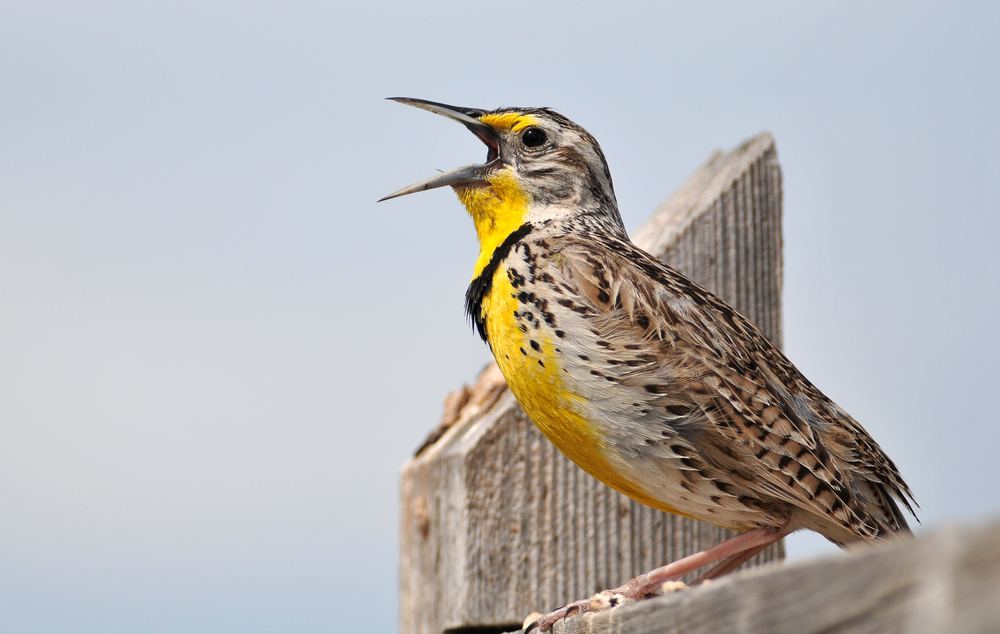
The Western Meadowlark is frequently observed in Saskatchewan during the summer season, particularly from March to October in the southern part of the province. It is documented in 29% of checklists during this period.
With its vibrant yellow belly and melodious song, the Western Meadowlark has the ability to brighten up your day.
Belonging to the blackbird family, Western Meadowlarks are similar in size to Robins and exhibit shades of brown and white on their upper parts. They have a black V-shaped band across their bright yellow chest, which turns gray in the winter.
Scientific name: Sturnella neglecta
Length: 6.3-10.2 inches (16-26 cm)
Weight: 3.1-4.1 ounces (89-115 g)
Wingspan: 16.1 inches (41 cm)
While Western Meadowlarks that breed in northern US states and Canada migrate to more southern states during winter, those in the west and midwest remain in the region throughout the year.
You can typically find Western Meadowlarks on the ground in grasslands, meadows, and fields. They forage alone or in small flocks and are not commonly found in wooded areas or dense shrubs.
Their diet primarily consists of insects during the summer and shifts towards seeds and grain during the winter season.
If you’re curious about the sounds made by Western Meadowlarks, they produce a pleasant series of tweets, warbles, and whistles. You can listen to their beautiful whistles and warbles in the accompanying video.
Western Meadowlarks build their nests in depressions on the ground in grasslands. These nests are lined with soft materials such as grass and may have a roof made of grass and plant stalks.
To attract Western Meadowlarks to your backyard, consider providing them with sunflower seeds and cracked corn.
Interesting fact: Western Meadowlarks have been designated as the state bird in six different US states.
2. Yellow Warbler
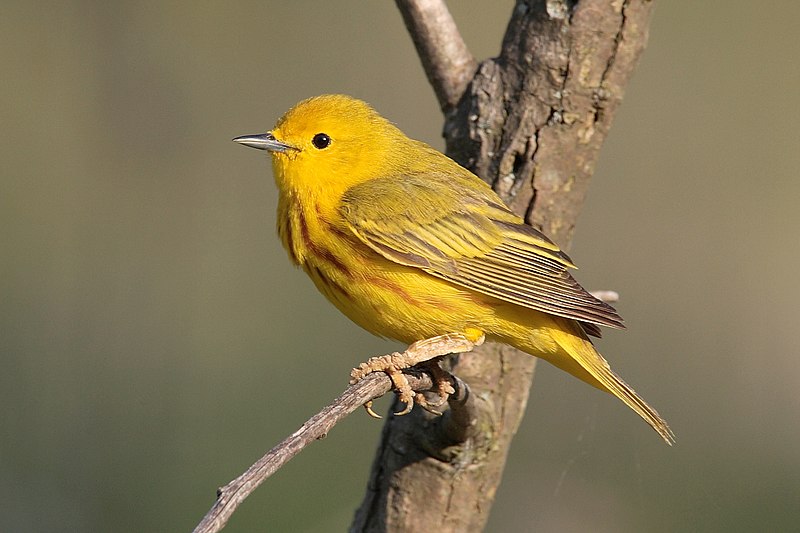
The Yellow Warbler is the most commonly sighted yellow bird in Saskatchewan during
the breeding season. It can be observed from May to September and appears in 29% of checklists during the summer.
Yellow Warblers are small birds with bright yellow plumage, yellow-green backs, and chestnut streaks on the breast in males. Females and juveniles are not as vibrant as the males.
Scientific name: Setophaga petechia
Length: 4.7-5.1 inches (12-13 cm)
Weight: 0.3-0.4 ounces (9-11 g)
Wingspan: 6.3-7.9 inches (16-20 cm)
Yellow Warblers undertake long-distance migrations to breed in Canada and the US, except for southeastern states. After breeding, they migrate back to Central and South America for winter. However, they can be spotted during migration in southeastern US states.
These birds can be found along streams, wetlands, and field edges, where they forage for insects such as caterpillars, midges, beetles, bugs, and wasps.
If you’re curious about the song of the Yellow Warbler, you can listen to it in the provided audio recording.
Yellow Warbler nests are typically built in small trees or shrubs using materials like bark, grass, and plant matter, woven together and secured with spider webs. The nests are lined with softer materials such as hair, feathers, and plant down.
They lay up to seven eggs, which take approximately twelve days to hatch. The young birds then spend an additional ten days in the nest before leaving.
To attract Yellow Warblers to your backyard, consider offering suet, oranges, peanut butter, and planting berry-producing plants. Additionally, opt for native plants that attract insects without the use of pesticides and maintain a slightly wilder garden. Birdbaths with fountains placed near secluded plantings can provide protection as well.
Interesting fact: Cowbirds often lay their eggs in Yellow Warblers’ nests. If detected, the Yellow Warblers construct a new nest on top of the old one, discarding the eggs and starting anew. This process can be repeated up to six times!
3. American Goldfinch

American Goldfinches are observed in southern Saskatchewan during the breeding season, primarily from May to September. They appear in 22% of checklists during the summer.
These birds are quite popular, especially due to the vibrant black and bright yellow plumage displayed by the males during spring. In contrast, females are duller brown, and males become less vibrant in the winter.
Scientific name: Spinus tristis
Length: 4.3-5.1 inches (11-13 cm)
Weight: 0.4-0.7 ounces (11-20 g)
Wingspan: 7.5-8.7 inches (19-22 cm)
American Goldfinches can be found across most of North America and typically reside there throughout the year. However, those breeding in Canada and the Midwest migrate to southern US states for winter.
You can spot American Goldfinches in weedy fields, overgrown areas, suburbs, parks, and even backyards. They forage on sunflower, thistle, and aster plants.
If you’re curious about the sounds made by American Goldfinches, you can listen to their distinctive call in the provided audio recording.
American Goldfinch nests are usually located in shrubs and are constructed using rootlets, plant material, and held together with spider webs. The eggs, usually numbering up to seven, take around two weeks to hatch, and the young birds leave the nest in two to two and a half weeks.
To attract American Goldfinches to your backyard, consider planting thistles and milkweed. They visit various bird feeders and
prefer sunflower seeds and nyjer seed.
Interesting fact: Cowbirds have no success in convincing American Goldfinches to raise their young. The vegetarian diet of American Goldfinches is unsuitable for cowbird chicks, causing them to perish within a few days.
4. Yellow-rumped Warbler
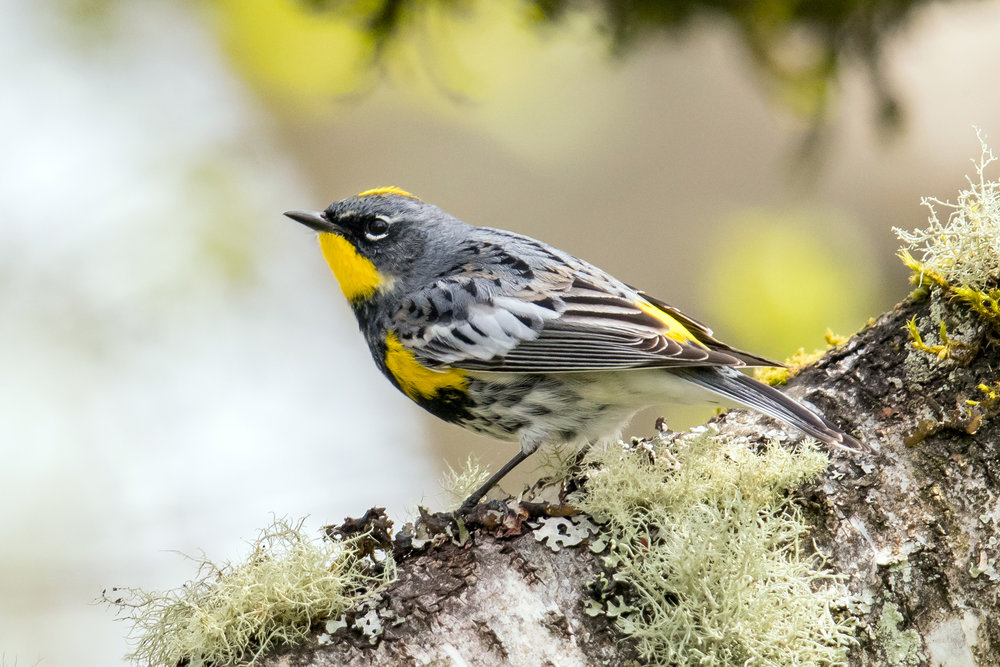
During the breeding season in Saskatchewan, Yellow-rumped Warblers can be spotted, but their numbers increase significantly during migration in May and September. They appear in 9% of summer checklists and up to 44% of checklists during migration.
Yellow-rumped Warblers have gray plumage with yellow flashes on the face, sides, and rump, along with white in the wings. Females may exhibit a slightly brown hue, and winter birds have paler brown plumage with bright yellow rumps and sides, which transition back to yellow and gray in spring.
Scientific name: Setophaga coronata
Length: 4.7-5.5 inches (12-14 cm)
Weight: 0.4-0.5 ounces (12-13 g)
Wingspan: 7.5-9.1 inches (19-23 cm)
Yellow-rumped Warblers primarily breed in Canada, parts of the Rockies, and the Appalachian mountains. During migration, they can be observed in the Midwest before overwintering in southern and southwestern US states, the Pacific Coast, Mexico, and Central America.
These warblers can be found in coniferous forests, particularly during the breeding season. In winter, they frequent open areas with fruiting shrubs. Their diet shifts from predominantly insects during summer to fruit consumption, including bayberry and wax myrtle, during migration and winter.
If you’re curious about the song of the Yellow-rumped Warbler, you can listen to it in the provided audio recording.
Yellow-rumped Warbler nests are constructed by females in conifer trees using twigs, pine needles, and grass. The nests are lined with soft grass, moss, and hair. They lay up to six eggs, which hatch in approximately two weeks. The young birds then spend around two weeks in the nest before departing.
To attract Yellow-rumped Warblers to your backyard, offer sunflower seeds, suet, raisins, and peanut butter.
Interesting fact: Yellow-rumped Warblers form flocks that can number in the thousands during winter, displaying aggression towards other species that venture too close.
5. Cedar Waxwing
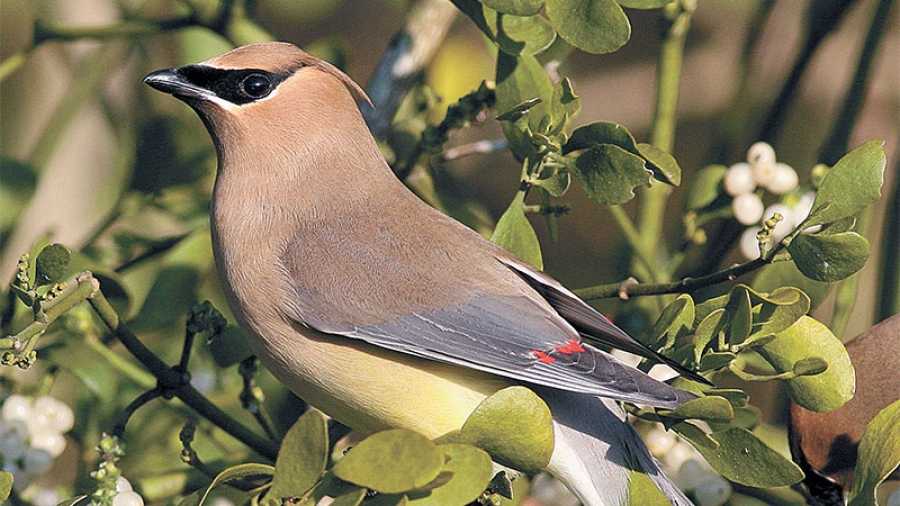
Cedar Waxwings can be observed in Saskatchewan during the breeding season, primarily from June to September. However, a few individuals may stay throughout the year. They appear in 12% of summer checklists.
Cedar Waxwings are elegant and social birds with pale brown heads, chests, and crests that fade to gray on their backs, wings, and tail. They have a pale yellow belly, and their wingtips display bright yellow accents. A narrow black mask can be observed over their eyes, and their wingtips are adorned with bright red.
Scientific name: Bombycilla cedrorum
Length: 5.5-6.7 inches (14-17 cm)
Weight: 1.1 ounces (32 g)
Wingspan: 8.7-11.8 inches (22-30 cm)
Cedar Waxwings breed in Canada before migrating to the southern US, Mexico, and Central America for winter. Some individuals remain in northern US states throughout the year.
You can find Cedar Waxwings in berry bushes, woodlands, grasslands, towns, and along streams. They mainly feed on fruit but also consume insects during the summer.
If you’re curious about the call of Cedar Waxwings, you can listen to it in the provided audio recording.
Cedar Waxwing nests are built in trees using twigs, grass, hair, and plant material. The nests are lined with pine needles and soft grass. They lay up to six eggs, which take around twelve days to hatch. The young birds then spend approximately sixteen days in the nest before fledging.
To attract Cedar Waxwings to your backyard, consider planting native trees and shrubs that bear small fruit, such as serviceberry, dogwood, juniper, winterberry, and hawthorn. Additionally, fruit on platform feeders can entice them.
Interesting fact: Cedar Waxwings engage in a unique behavior during courtship, exchanging gifts between potential mates.
6. Yellow-headed Blackbird
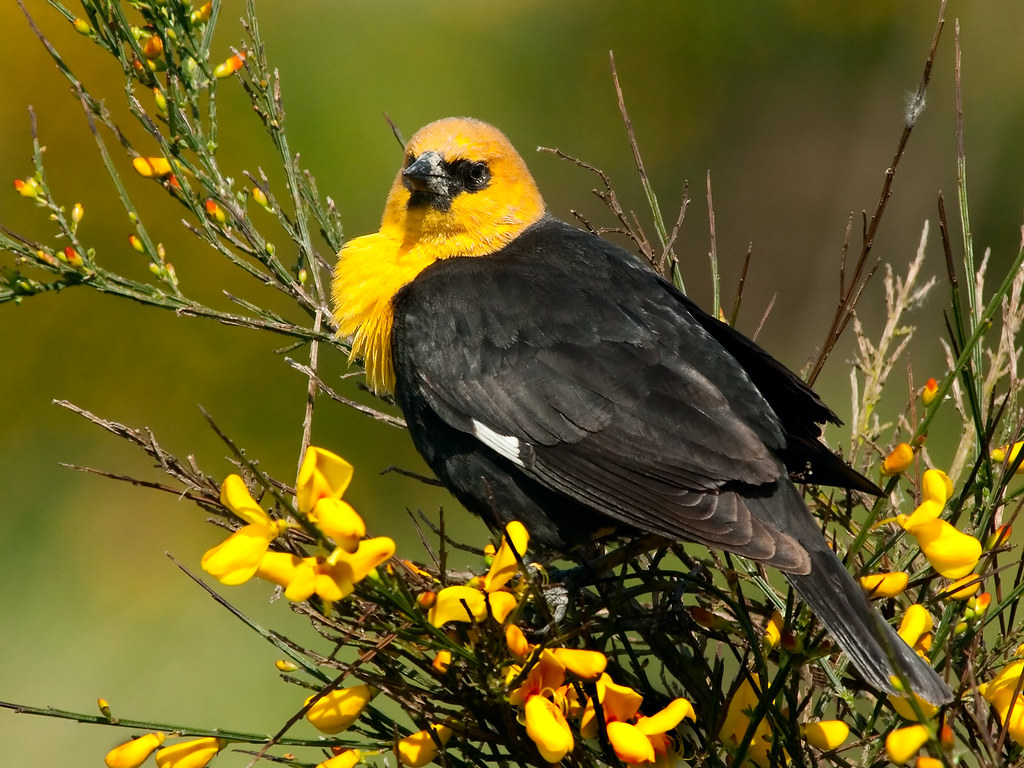
Yellow-headed Blackbirds are primarily observed in Saskatchewan from April to October, with their presence peaking in the summer season. They are present in 15% of summer checklists.
These blackbirds are striking, with glossy black bodies, bright yellow heads and chests, and white patches on their wings in males. Females possess a brown plumage instead of black, and their yellow heads are less vibrant. Yellow-headed Blackbirds are larger than Red-winged Blackbirds.
Scientific name: Xanthocephalus xanthocephalus
Length: 8.3-10.2 inches (21-26 cm)
Weight: 1.6-3.5 ounces (44-100 g)
Wingspan: 16.5-17.3 inches (42-44 cm)
Yellow-headed Blackbirds breed in western and prairie wetlands, constructing their nests within the reeds. They forage over the surrounding wetlands, grasslands, and fields, primarily feeding on insects during the summer season.
After breeding, Yellow-headed Blackbirds migrate to fields and farmlands in Southwest states and Mexico for winter, often forming large flocks.
These blackbirds consume insects during summer and switch to a diet of seeds and grains during winter.
If you’re curious about the sounds made by Yellow-headed Blackbirds, you can listen to their distinct screeching buzz and musical notes in the provided audio recording.
Yellow-headed Blackbird nests are constructed from long wet stems, woven together and attached to cattails or reeds over the water. They lay 2 to 5 eggs, which take around two weeks to hatch. The young birds spend an additional week or two before fledging.
To attract Yellow-headed Blackbirds to your yard, provide sunflower seeds.
Interesting fact: Yellow-headed Blackbirds flip over stones to flush out insects, using this unique hunting method to find their prey.
7. Baltimore Oriole (Female)

Baltimore Orioles can be observed in southern Saskatchewan during the summer season, particularly from May to September. They appear in 11% of checklists during this period.
Baltimore Orioles are colorful symbols of spring in the eastern part of North America. Adult males boast bright orange and black plumage with white wing bars on their black wings.
Females have a yellowish underside and head, with grayish-brown wings. Their backs exhibit brownish-yellow tones. Baltimore Orioles are similar in size to Robins but possess a more slender physique. They belong to the blackbird family.
Scientific name: Icterus galbula
Length: 6.7-7.5 inches (17-19 cm)
Weight: 1.1-1.4 ounces (30-40 g)
Wingspan: 9.1-11.8 inches (23-30 cm)
Baltimore Orioles breed in Eastern and Central states, including central-southern Canadian provinces along the US southern border. They then migrate to Florida, Central America, and the Caribbean for winter, beginning their departure as early as July.
You can find Baltimore Orioles in open woodlands, riverbanks, forest edges, and they often visit parks and backyards. Their diet primarily consists of insects such as beetles, crickets, grasshoppers, spiders, and snails. They also consume a wide variety of fruits, although they can cause damage to crops like raspberries, mulberries, cherries, bananas, and oranges.
If you’re curious about the flute-like sounds produced by Baltimore Orioles, you can listen to them in the provided audio recording. They also emit chattering and sharp alarm calls.
To attract Baltimore Orioles to your backyard, provide oranges cut in half on a platform feeder or hang them from trees. Oriole feeders filled with sugar water can also be used. Planting fruiting plants and nectar-rich plants like raspberries, crab apples, and trumpet vines may also entice them.
Interesting fact: Baltimore Orioles construct incredible bag-like nests woven from fibers.
8. Western Kingbird
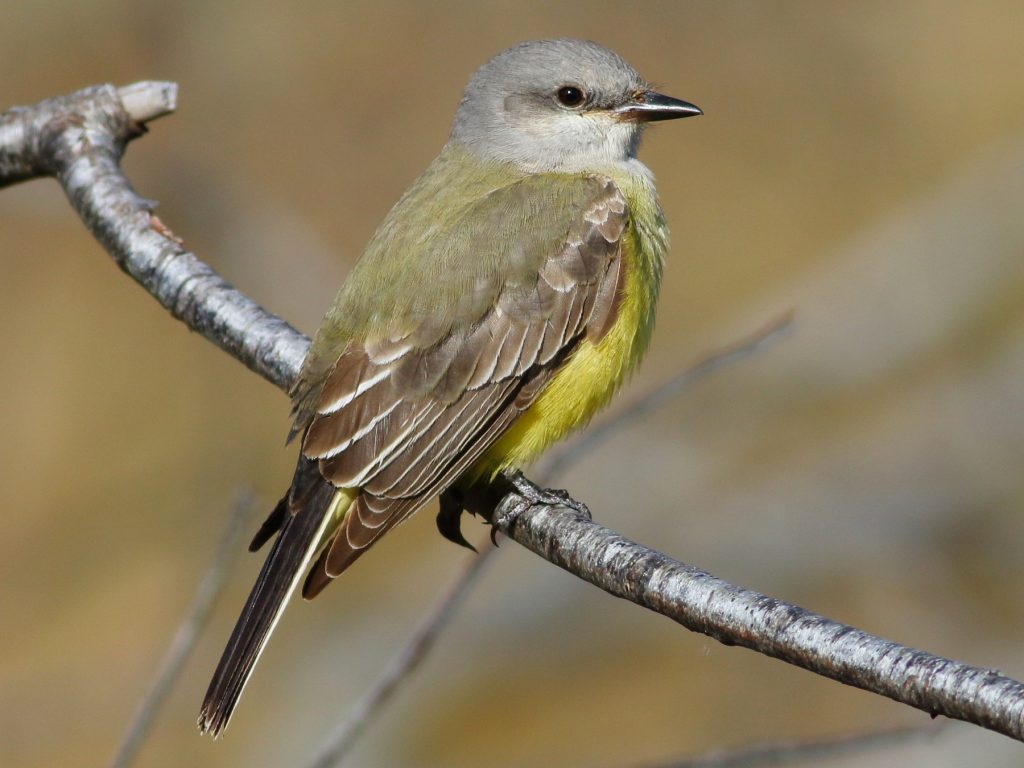
Western Kingbirds spend their summers in Saskatchewan and are present in 10% of checklists during this time. They can be observed from May to September in the southern part of the province.
Western Kingbirds are large flycatchers with yellow bellies, whitish chests, gray heads, grayish-brown wings, and black tails with white edges.
Scientific name: Tyrannus verticalis
Length: 7.9-9.4 inches (20-24 cm)
Weight: 1.3-1.6 ounces (37-46 g)
Wingspan: 15.0-16.1 inches (38-41 cm)
During the summer, Western Kingbirds breed in western US states, the plains region, and parts of Canada. They migrate to Mexico and Central America for winter, although some individuals may overwinter in the southern regions of Florida.
You can find Western Kingbirds in open habitats, often perched on fences and utility lines, patiently waiting for flying insects to pass by before catching them in mid-flight.
If you’re curious about the call of Western Kingbirds, you can listen to it in the provided audio recording.
Western Kingbird nests are usually built in trees or shrubs but can also be found in human-made structures like buildings or posts. The female constructs the nest using twigs, grass, and plant materials, weaving them into a cup-like shape.
They lay up to seven eggs, which take around two to three weeks to hatch. The young birds remain in the nest for the same duration before leaving.
To attract Western Kingbirds to your yard, create an insect-friendly environment and consider planting elderberry or hawthorn, which they also enjoy consuming.
Interesting fact: Western Kingbird parents continue to feed their young for an additional three weeks after they leave the nest.
9. Common Yellowthroat
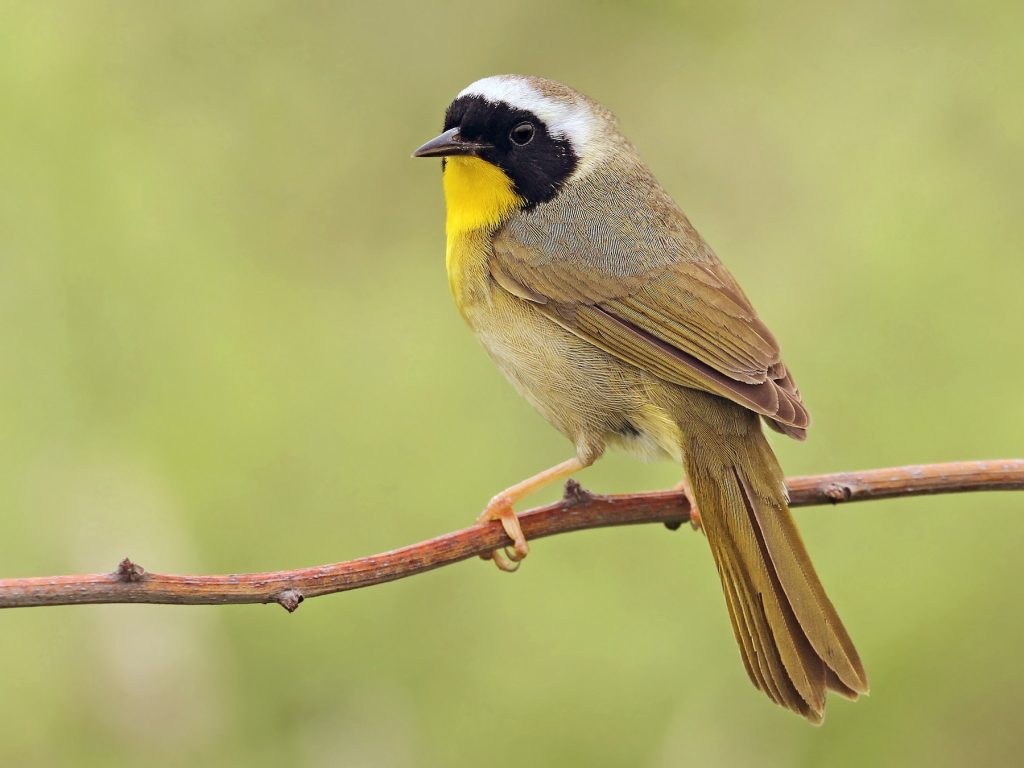
Common Yellowthroats spend the breeding season in Saskatchewan and appear in 9% of checklists during the summer. They arrive in April and start migrating in October.
Common Yellowthroats are small songbirds with brownish backs and bright yellow undersides. They possess long tails, and the males feature black masks across their faces. The vibrancy of their yellow plumage can vary geographically, with some individuals displaying more olive tones underneath.
Scientific name: Geothlypis trichas
Length: 4.3-5.1 inches (11-13 cm)
Weight: 0.3-0.3 ounces (9-10 g)
Wingspan: 5.9-7.5 inches (15-19 cm)
Common Yellowthroats breed across most of North America, excluding Alaska and northern Canada. Some individuals remain along the Gulf Coast and Pacific Southwest throughout the year. They migrate south for winter, and during this period, they can be seen in all US states except the northeastern region.
You can find Common Yellowthroats in marshy areas, wetlands, and brushy fields, where they inhabit thick and tangled vegetation.
If you’re curious about the song of Common Yellowthroats, you can listen to it in the provided audio recording.
Common Yellowthroat nests are constructed near or on the ground in marshy areas, using dead leaves, twigs, and stems. The nests are supported by a platform of leaves and grass and lined with soft grass and animal hair. They lay up to six eggs.
To attract Common Yellowthroats to your backyard, create a habitat with dense vegetation and native plants that attract insects.
Interesting fact: The presence of a black mask on Common Yellowthroats serves as a visual signal to courting males, who may become aggressive when fake birds without masks are introduced.
10. Orange-crowned Warbler
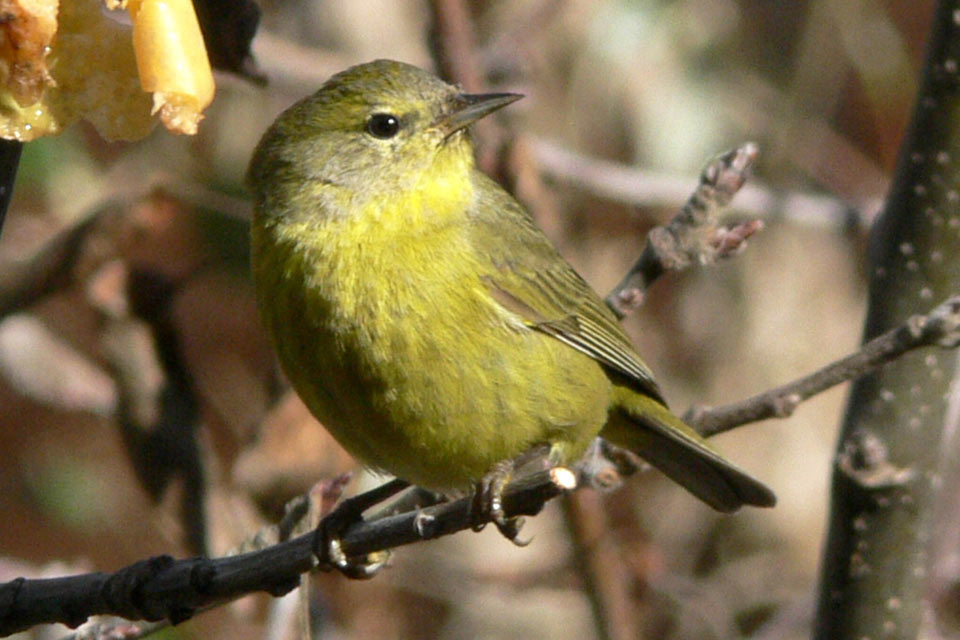
Orange-crowned Warblers can be spotted in Saskatchewan during the summer season, primarily from mid-April until October. However, they are most commonly seen during the fall migration and appear in 24% of checklists during this period.
Orange-crowned Warblers are not as vibrantly colored as other warbler species. They exhibit yellow-olive plumage, which tends to be more yellow on the Pacific Coast. Their orange crown is rarely visible.
Scientific name: Leiothlypis celata
Length: 4.3-5.5 inches (11-14 cm)
Weight: 0.3-0.4 ounces (7-11 g)
Wingspan: 7.5 inches (19 cm)
Orange-crowned Warblers breed in Canada and western US states before migrating to the Pacific Coast, East Coast, Gulf Coast, Mexico, and Central America. They can also be observed during migration in all US states except the northeastern region.
You can find Orange-crowned Warblers in shrubs and low-lying vegetation, although they breed in open woodlands. Their diet primarily consists of spiders and insects such as caterpillars and flies. They also visit backyard feeders and consume a variety of fruits.
If you’re curious about the song of Orange-crowned Warblers, you can listen to it in the provided audio recording.
Orange-crowned Warbler nests are located near or on the ground and are constructed from dead leaves, twigs, and stems. They are lined with soft grass and animal hair. They lay up to six eggs.
To attract Orange-crowned Warblers to your yard, offer suet, peanut butter, or hummingbird feeders filled with sugar water nectar.
Interesting fact: Orange-crowned Warblers are known to drink sap from sapwells created by sapsuckers and woodpeckers.
11. Scarlet Tanager
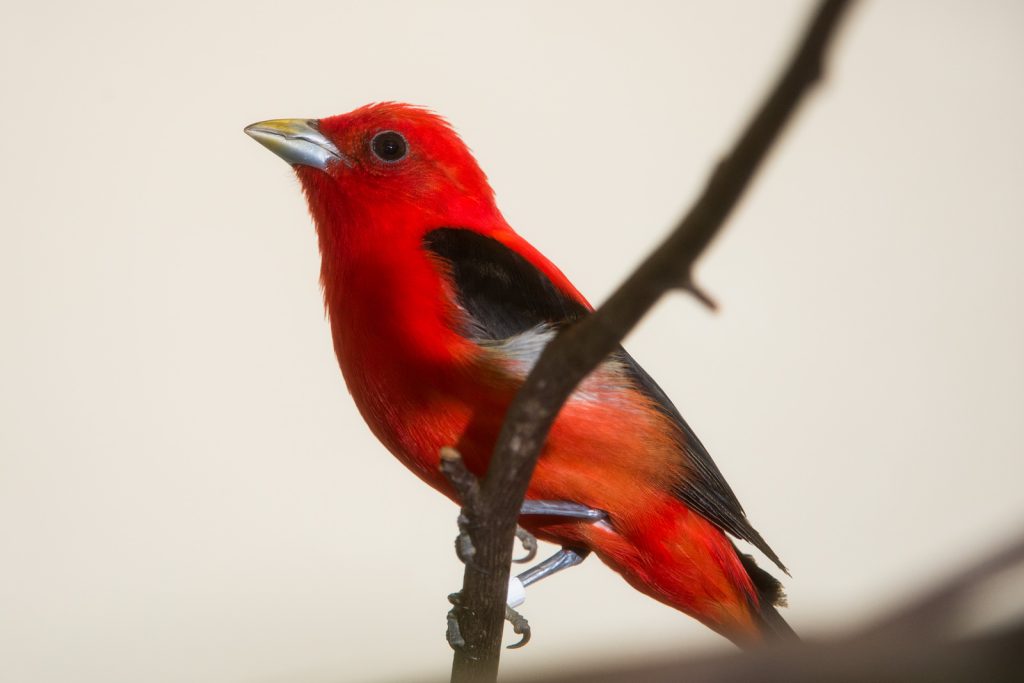
Scarlet Tanagers can be spotted in Saskatchewan during the summer season, particularly from May to September. They appear in 8% of summer checklists.
Scarlet Tanagers are stunning birds, with bright red plumage for the males and olive-yellow plumage for the females. They have stout beaks and are about the same size as a Robin.
Scientific name: Piranga olivacea
Length: 6.3-7.5 inches (16-19 cm)
Weight: 1.1-1.4 ounces (31-40 g)
Wingspan: 9.8-11.8 inches (25-30 cm)
Scarlet Tanagers breed in deciduous forests across eastern North America, including parts of Canada. During winter, they migrate to the northern regions of South America.
You can find Scarlet Tanagers high up in the forest canopy, where they forage for insects and occasionally consume fruits.
If you’re curious about the song of Scarlet Tanagers, you can listen to it in the provided audio recording.
Scarlet Tanager nests are built on horizontal branches of trees using twigs, grass, and leaves. They lay 3 to 4 eggs, which hatch in approximately two weeks. The young birds spend about ten days in the nest before fledging.
To attract Scarlet Tanagers to your backyard, create a habitat with tall trees and provide a water source.
Interesting fact: Male Scarlet Tanagers undergo a molting process in late summer, shedding their vibrant red plumage and adopting a yellow-green appearance similar to the females.
12. Western Tanager

Western Tanagers spend their summers in Saskatchewan and appear in 7% of summer checklists. They can be observed from May to September.
Western Tanagers have bright yellow plumage with black wings, back, and tail. The males display a distinctive red face and black throat. Females possess a yellow-green body with a grayish back.
Scientific name: Piranga ludoviciana
Length: 6.3-7.5 inches (16-19 cm)
Weight: 0.6-1.1 ounces (18-32 g)
Wingspan: 9.1-10.6 inches (23-27 cm)
During the breeding season, Western Tanagers breed in the western part of North America, including parts of Canada. They migrate to Mexico and Central America for winter.
You can find Western Tanagers in open woodlands, forest edges, and mountainous areas, where they forage for insects and consume fruits.
If you’re curious about the call of Western Tanagers, you can listen to it in the provided audio recording.
Western Tanager nests are typically built on horizontal branches of coniferous trees using twigs, grass, and moss. They lay 3 to 5 eggs, which hatch in approximately two weeks. The young birds remain in the nest for about two weeks before fledging.
To attract Western Tanagers to your backyard, provide a water source, offer fruit, and create a habitat with trees and shrubs.
Interesting fact: Western Tanagers are known for their unique migratory pattern. They travel from the western part of North America to the northern part of South America during winter, crossing the vast distance of the continent.
13. Orchard Oriole
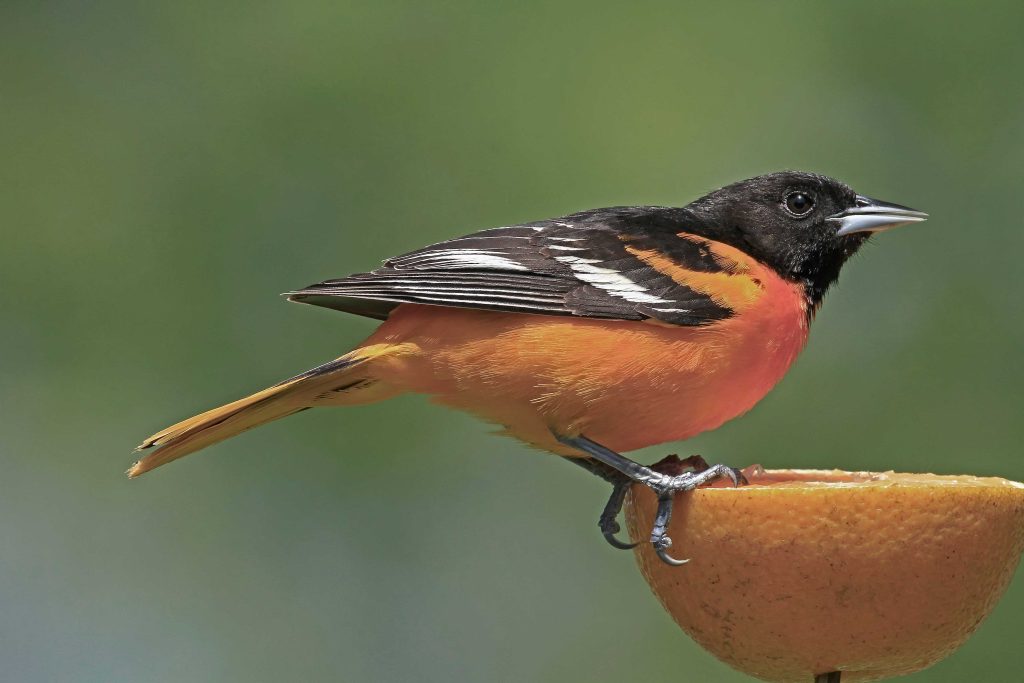
Orchard Orioles can be spotted in Saskatchewan during the summer season, mainly from May to September. They appear in 7% of summer checklists.
Orchard Orioles are small songbirds with bright orange or yellowish-orange plumage for the males and olive-green plumage for the females. They are about the size of a House Finch.
Scientific name: Icterus spurius
Length: 6.3-7.1 inches (16-18 cm)
Weight: 0.5-1.0 ounce (14-28 g)
Wingspan: 8.7-11.4 inches (22-29 cm)
Orchard Orioles breed across eastern and central North America, including parts of Canada. During winter, they migrate to Mexico, Central America, and the northern regions of South America.
You can find Orchard Orioles in open woodlands, orchards, and groves, where they forage for insects, spiders, and occasionally consume fruits.
If you’re curious about the sounds produced by Orchard Orioles, you can listen to them in the provided audio recording.
Orchard Oriole nests are intricately woven using grass, plant fibers, and bark strips, suspended from the outer branches of trees. They lay 3 to 6 eggs, which hatch in approximately two weeks. The young birds remain in the nest for about two weeks before fledging.
To attract Orchard Orioles to your backyard, provide a water source, offer orange halves, and create a habitat with fruit-bearing trees and shrubs.
Interesting fact: Male Orchard Orioles can be polygynous, meaning they may mate with multiple females and participate in nest-building and feeding duties for each female.
14. Yellow-throated Vireo
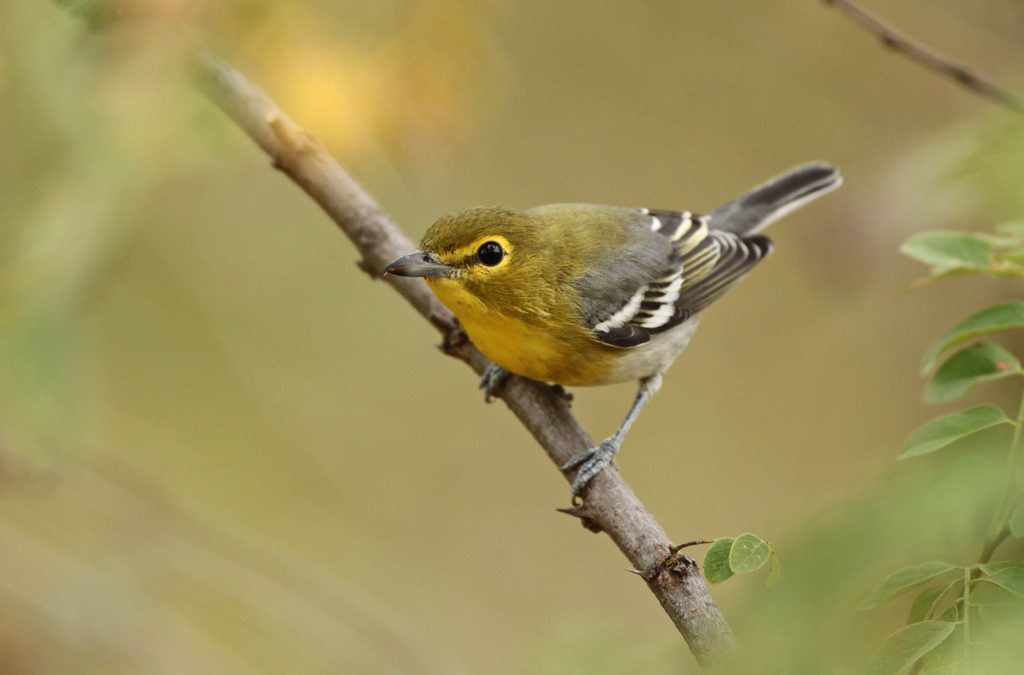
Yellow-throated Vireos spend their summers in Saskatchewan and appear in 6% of summer checklists. They can be observed from May to September.
Yellow-throated Vireos have olive-green plumage on their backs, wings, and tails, with bright yellow throats and undersides. They have a distinct white eyering. They are about the same size as a Black-capped Chickadee.
Scientific name: Vireo flavifrons
Length: 5.5-5.9 inches (14-15 cm)
Weight: 0.5-0.6 ounce (15-18 g)
Wingspan: 9.8-10.6 inches (25-27 cm)
During the breeding season, Yellow-throated Vireos breed across eastern North America, including parts of Canada. They migrate to Central America and the northern regions of South America for winter.
You can find Yellow-throated Vireos in deciduous and mixed forests, where they forage for insects and occasionally consume fruits.
If you’re curious about the song of Yellow-throated Vireos, you can listen to it in the provided audio recording.
Yellow-throated Vireo nests are typically built on horizontal branches of trees, using grass, plant fibers, and bark. They lay 3 to 5 eggs, which hatch in approximately two weeks. The young birds spend about two weeks in the nest before fledging.
To attract Yellow-throated Vireos to your backyard, provide a water source and create a habitat with tall trees and dense foliage.
Interesting fact: Yellow-throated Vireos are known for their distinctive songs, which are often described as a repeated series of melodic phrases.
15. American Redstart
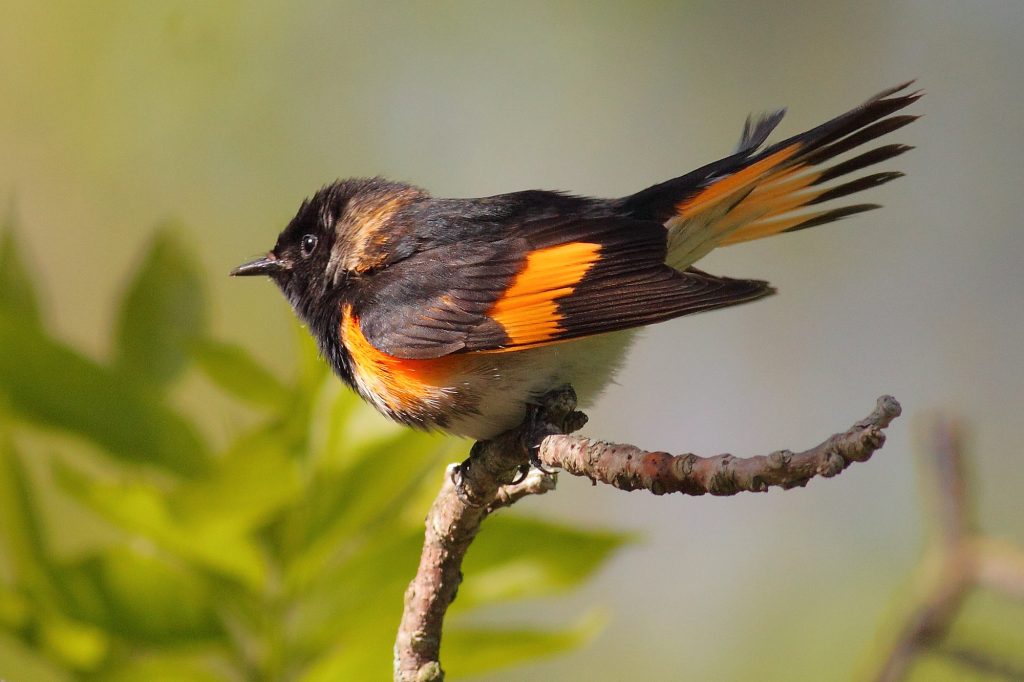
American Redstarts can be spotted in Saskatchewan during the summer season, particularly from May to September. They appear in 6% of summer checklists.
American Redstarts are small songbirds with black upperparts, bright orange or yellow-orange patches on their sides, wings, and tails, and white undersides. They have a distinct habit of constantly flicking their wings and tail.
Scientific name: Setophaga ruticilla
Length: 4.3-5.1 inches (11-13 cm)
Weight: 0.3-0.4 ounce (8-11 g)
Wingspan: 6.7-7.5 inches (17-19 cm)
American Redstarts breed across North America, including parts of Canada. During winter, they migrate to the Caribbean, Central America, and the northern regions of South America.
You can find American Redstarts in deciduous and mixed forests, where they forage for insects, spiders, and occasionally consume fruits.
If you’re curious about the song of American Redstarts, you can listen to it in the provided audio recording.
American Redstart nests are cup-shaped and built on the branches of trees, using grass, plant fibers, and bark. They lay 3 to 5 eggs, which hatch in approximately two weeks. The young birds remain in the nest for about two weeks before fledging.
To attract American Redstarts to your backyard, provide a water source and create a habitat with trees and shrubs.
Interesting fact: American Redstarts are known for their unique foraging behavior, as they actively flutter their wings to disturb insects and capture them in mid-air.
16. Magnolia Warbler
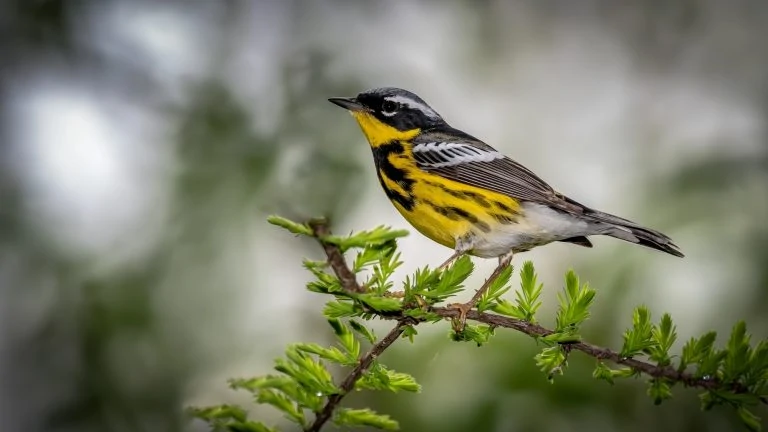
Magnolia Warblers can be observed in Saskatchewan during the summer season, particularly from May to September. They appear in 5% of summer checklists.
Magnolia Warblers have black streaks on their yellow undersides, with black and white streaking on their backs and wings. They possess a distinct black mask across their faces.
Scientific name: Setophaga magnolia
Length: 4.3-5.1 inches (11-13 cm)
Weight: 0.3-0.4 ounce (8-11 g)
Wingspan: 6.3-7.1 inches (16-18 cm)
During the breeding season, Magnolia Warblers breed in Canada and parts of the northeastern United States. They migrate to Central America and the Caribbean for winter.
You can find Magnolia Warblers in deciduous and mixed forests, where they forage for insects and occasionally consume fruits.
If you’re curious about the song of Magnolia Warblers, you can listen to it in the provided audio recording.
Magnolia Warbler nests are usually built on the ground, hidden among grasses and vegetation, using leaves, moss, and plant fibers. They lay 3 to 5 eggs, which hatch in approximately two weeks. The young birds spend about two weeks in the nest before fledging.
To attract Magnolia Warblers to your backyard, provide a water source and create a habitat with trees and shrubs.
Interesting fact: The name “Magnolia Warbler” was given to this species by ornithologist Alexander Wilson, who named it after the magnolia-like pattern on the male’s back.
17. Nashville Warbler
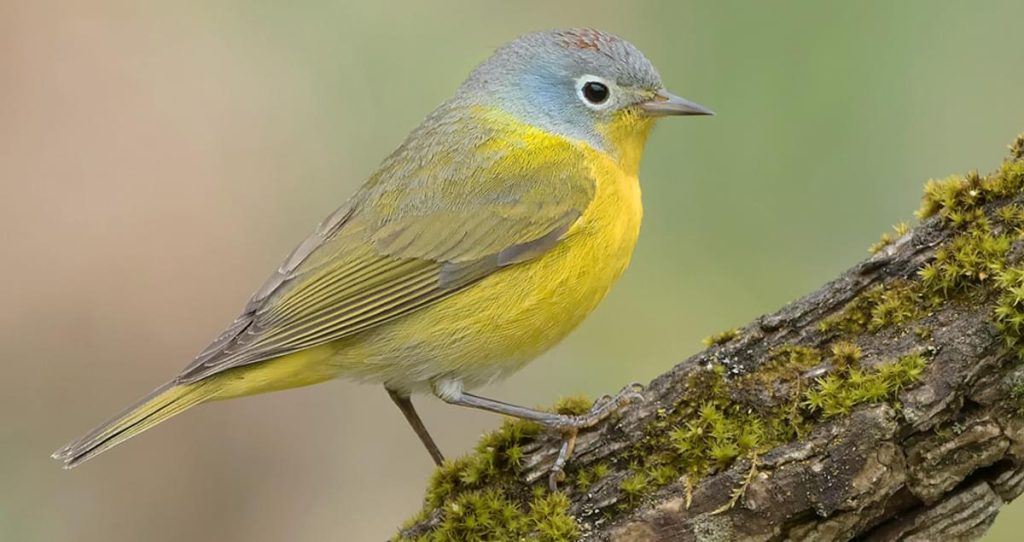
Nashville Warblers spend their summers in Saskatchewan and appear in 5% of summer checklists. They can be observed from May to September.
Nashville Warblers have bright yellow undersides, olive-green backs, and gray crowns. They are small songbirds with slender bodies.
Scientific name: Leiothlypis ruficapilla
Length: 4.3-5.1 inches (11-13 cm)
Weight: 0.3-0.4 ounce (8-11 g)
Wingspan: 6.3-7.1 inches (16-18 cm)
During the breeding season, Nashville Warblers breed in Canada and parts of the northeastern United States. They migrate to Mexico and Central America for winter.
You can find Nashville Warblers in forests, woodlands, and shrubby areas, where they forage for insects, spiders, and occasionally consume fruits.
If you’re curious about the song of Nashville Warblers, you can listen to it in the provided audio recording.
Nashville Warbler nests are usually built close to the ground, hidden among vegetation, using grass, plant fibers, and bark.
They lay 4 to 5 eggs, which hatch in approximately two weeks. The young birds spend about two weeks in the nest before fledging.
To attract Nashville Warblers to your backyard, provide a water source and create a habitat with trees, shrubs, and dense foliage.
Interesting fact: Nashville Warblers are named after the city of Nashville, Tennessee, where the first specimen of this species was collected.
18. Canada Warbler
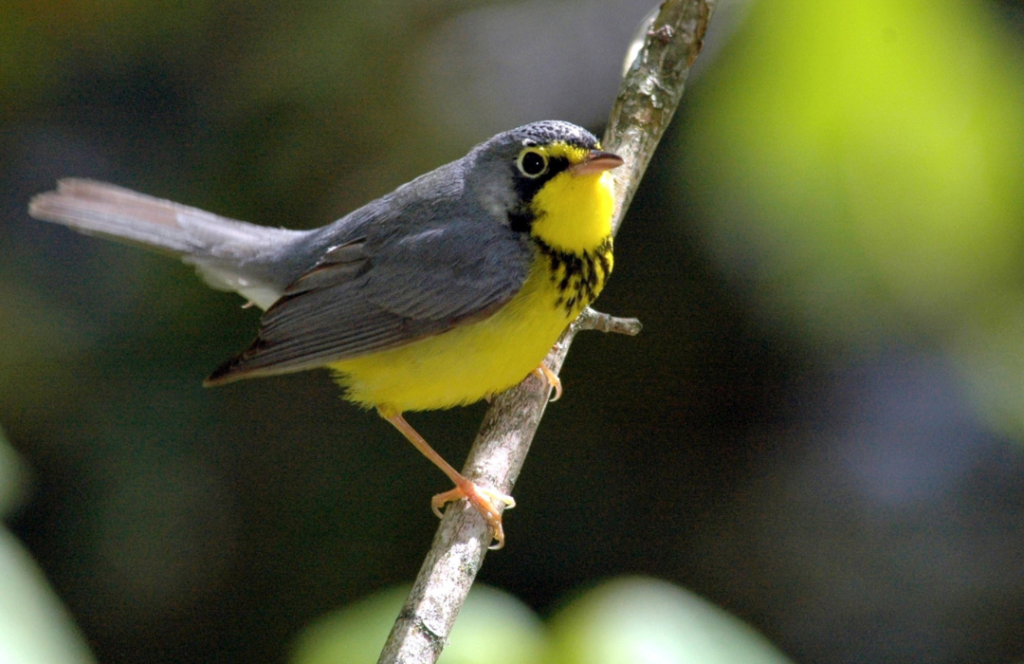
Canada Warblers can be spotted in Saskatchewan during the summer season, mainly from May to September. They appear in 4% of summer checklists.
Canada Warblers have gray upperparts, yellow undersides, and a distinct black necklace pattern across their throats and upper chests. They are small songbirds with a relatively long tail.
Scientific name: Cardellina canadensis
Length: 4.7-5.5 inches (12-14 cm)
Weight: 0.3-0.4 ounce (9-11 g)
Wingspan: 7.5-8.3 inches (19-21 cm)
During the breeding season, Canada Warblers breed in Canada and parts of the northeastern United States. They migrate to northern South America for winter.
You can find Canada Warblers in dense, moist forests, where they forage for insects and occasionally consume fruits.
If you’re curious about the song of Canada Warblers, you can listen to it in the provided audio recording.
Canada Warbler nests are typically built close to the ground, hidden among vegetation, using grass, plant fibers, and bark. They lay 4 to 5 eggs, which hatch in approximately two weeks. The young birds spend about two weeks in the nest before fledging.
To attract Canada Warblers to your backyard, provide a water source and create a habitat with trees, shrubs, and dense understory vegetation.
Interesting fact: Canada Warblers have one of the longest migratory journeys of any New World warbler, traveling from their breeding grounds in Canada to wintering areas in northern South America.
19. Black-throated Green Warbler

Black-throated Green Warblers spend their summers in Saskatchewan and appear in 4% of summer checklists. They can be observed from May to September.
Black-throated Green Warblers have bright yellow undersides, olive-green backs, and a black throat and face. They are small songbirds with a compact body structure.
Scientific name: Setophaga virens
Length: 4.7-5.1 inches (12-13 cm)
Weight: 0.3-0.4 ounce (8-11 g)
Wingspan: 7.5-8.3 inches (19-21 cm)
During the breeding season, Black-throated Green Warblers breed in Canada and parts of the northeastern United States. They migrate to the southeastern United States, the Caribbean, and Central America for winter.
You can find Black-throated Green Warblers in coniferous and mixed forests, where they forage for insects and occasionally consume fruits.
If you’re curious about the song of Black-throated Green Warblers, you can listen to it in the provided audio recording.
Black-throated Green Warbler nests are typically built on the ground, hidden among vegetation, using leaves, grass, and plant fibers. They lay 3 to 5 eggs, which hatch in approximately two weeks. The young birds spend about two weeks in the nest before fledging.
To attract Black-throated Green Warblers to your backyard, provide a water source and create a habitat with trees, shrubs, and dense foliage.
Interesting fact: Black-throated Green Warblers have a unique feeding behavior called “gleaning,” where they search for insects on leaves and twigs, often hanging upside-down to reach their prey.
20. Least Flycatcher
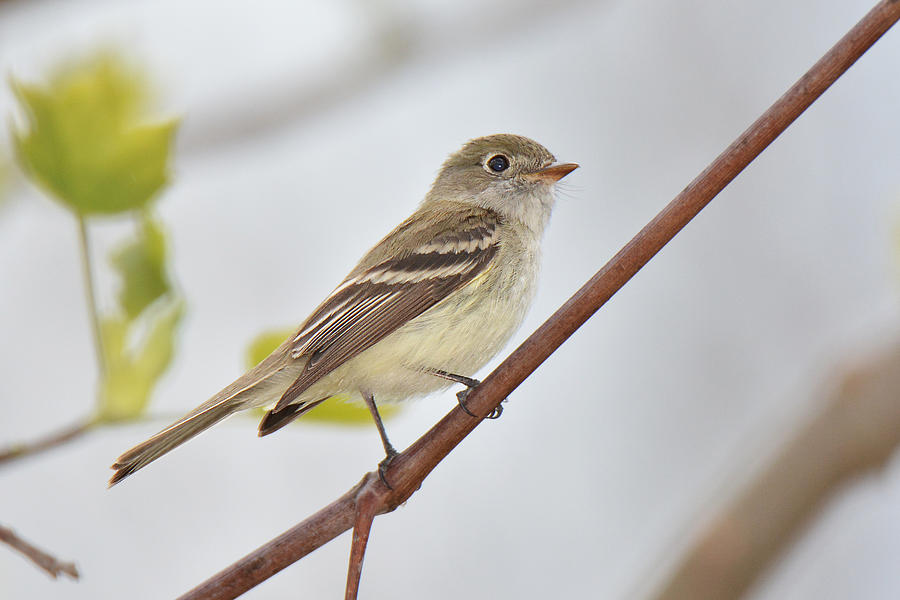
Least Flycatchers can be spotted in Saskatchewan during the summer season, particularly from May to September. They appear in 4% of summer checklists.
Least Flycatchers are small songbirds with grayish-olive upperparts and pale yellow undersides. They have a distinct eye ring and a small bill.
Scientific name: Empidonax minimus
Length: 5.1-5.5 inches (13-14 cm)
Weight: 0.3-0.4 ounce (9-11 g)
Wingspan: 7.5-8.3 inches (19-21 cm)
During the breeding season, Least Flycatchers breed across Canada and parts of the northeastern United States. They migrate to Central America and the northern regions of South America for winter.
You can find Least Flycatchers in open woodlands, forest edges, and shrubby areas, where they perch and wait for insects, which they catch in mid-air.
If you’re curious about the call of Least Flycatchers, you can listen to it in the provided audio recording.
Least Flycatcher nests are cup-shaped and built on horizontal branches of trees, using plant fibers, moss, and spider silk. They lay 3 to 4 eggs, which hatch in approximately two weeks. The young birds spend about two weeks in the nest before fledging.
To attract Least Flycatchers to your backyard, provide perching spots and create a habitat with trees and shrubs.
Interesting fact: Least Flycatchers are known for their distinctive call, which sounds like a sharp “che-bek” or “che-bek-ek.”
21. Western Tanager
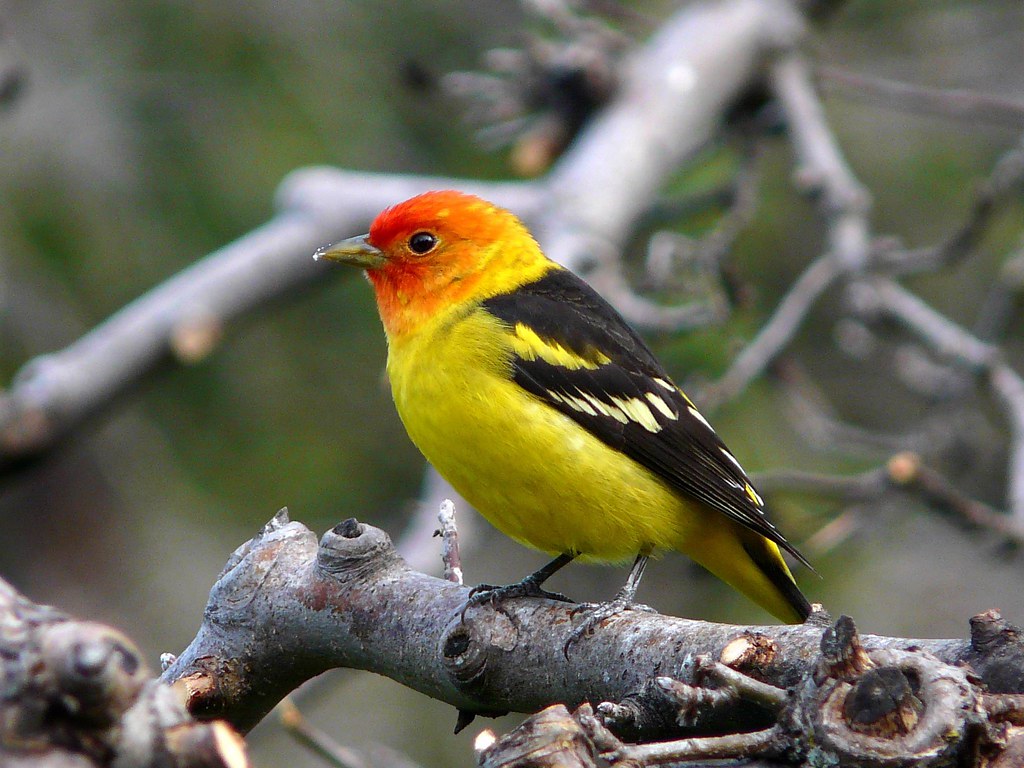
Western Tanagers spend their summers in Saskatchewan and appear in 3% of summer checklists. They can be observed from May to September.
Western Tanagers are striking birds with bright yellow bodies, reddish-orange heads, and black wings with white wing bars. They are medium-sized songbirds with a stout bill.
Scientific name: Piranga ludoviciana
Length: 6.3-7.1 inches (16-18 cm)
Weight: 0.7-1.0 ounce (20-28 g)
Wingspan: 9.8-11.4 inches (25-29 cm)
During the breeding season, Western Tanagers breed across western North America, including parts of Canada. They migrate to Mexico and Central America for winter.
You can find Western Tanagers in coniferous and mixed forests, woodlands, and open areas with trees, where they forage for insects and occasionally consume fruits.
If you’re curious about the song of Western Tanagers, you can listen to it in the provided audio recording.
Western Tanager nests are usually built in coniferous trees, using twigs, grass, and plant fibers. They lay 3 to 5 eggs, which hatch in approximately two weeks. The young birds spend about two weeks in the nest before fledging.
To attract Western Tanagers to your backyard, provide a water source and create a habitat with trees and shrubs, especially those that produce berries or attract insects.
Interesting fact: The bright colors of male Western Tanagers are the result of their diet, which includes insects that contain pigments called carotenoids.
22. Evening Grosbeak

Evening Grosbeaks can be spotted in Saskatchewan during the winter season, particularly from November to March. They appear in 2% of winter checklists.
Evening Grosbeaks are stocky birds with a large, conical bill. Males have yellow bodies with black and white wings, while females have grayish-brown bodies with yellow accents.
Scientific name: Coccothraustes vespertinus
Length: 7.1-8.7 inches (18-22 cm)
Weight: 1.6-2.3 ounces (45-65 g)
Wingspan: 12.2-14.6 inches (31-37 cm)
Evening Grosbeaks are highly nomadic and irregular in their winter distribution. They breed in western North America and parts of Canada. During winter, they can be found in various locations across North America, depending on food availability.
You can find Evening Grosbeaks in coniferous and deciduous forests, orchards, and feeders, where they feed on seeds, fruits, and buds.
If you’re curious about the call of Evening Grosbeaks, you can listen to it in the provided audio recording.
Evening Grosbeak nests are usually built in coniferous trees, using twigs, grass, and plant fibers. They lay 2 to 4 eggs, which hatch in approximately two weeks. The young birds spend about two weeks in the nest before fledging.
To attract Evening Grosbeaks to your backyard, provide a variety of seeds, such as sunflower seeds and nyjer seeds, and create a habitat with trees and shrubs.
Interesting fact: Evening Grosbeaks have a powerful bill that allows them to crack open hard seeds, such as cherry pits and conifer cones.
23. Palm Warbler
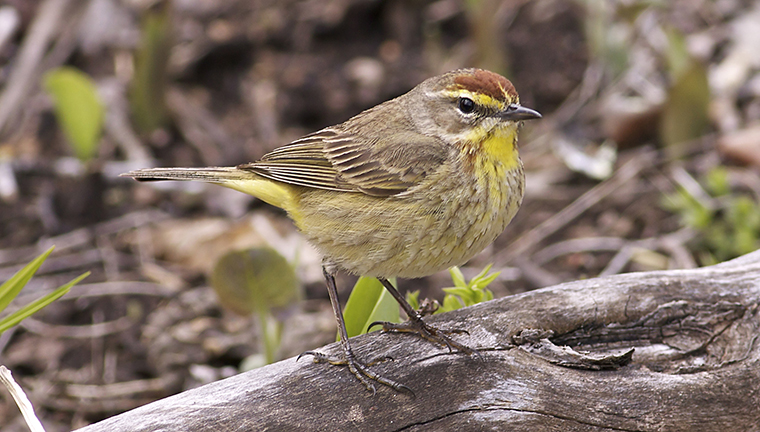
Palm Warblers can be observed in Saskatchewan during the migration seasons, particularly in spring and fall. They appear in 2% of migration checklists.
Palm Warblers have brownish-olive upperparts and yellow undersides with streaking. They have a distinct rusty cap and a wagging tail.
Scientific name: Setophaga palmarum
Length: 4.7-5.5 inches (12-14 cm)
Weight: 0.3-0.4 ounce (9-11 g)
Wingspan: 7.9-8.7 inches (20-22 cm)
Palm Warblers breed in the boreal forests of Canada and Alaska. During migration, they can be found in various parts of North America, including Saskatchewan, as they travel to their wintering grounds in the southeastern United States, the Caribbean, and Central America.
You can find Palm Warblers in open areas with trees, such as fields, meadows, and forest edges, where they forage for insects and occasionally consume berries.
If you’re curious about the song of Palm Warblers, you can listen to it in the provided audio recording.
Palm Warbler nests are usually built on the ground, hidden among vegetation, using grass, leaves, and moss. They lay 4 to 5 eggs, which hatch in approximately two weeks. The young birds spend about two weeks in the nest before fledging.
To attract Palm Warblers during migration, provide a water source and create a habitat with trees, shrubs, and open spaces.
Interesting fact: Palm Warblers are known for their distinctive tail wagging behavior, which is often seen as they forage on the ground.